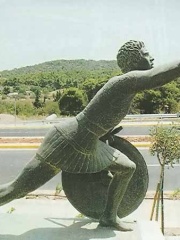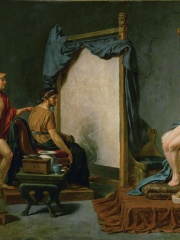



The Most Famous
SOCIAL ACTIVISTS from Greece
This page contains a list of the greatest Greek Social Activists. The pantheon dataset contains 840 Social Activists, 4 of which were born in Greece. This makes Greece the birth place of the 45th most number of Social Activists behind Belgium, and Australia.
Top 4
The following people are considered by Pantheon to be the most legendary Greek Social Activists of all time. This list of famous Greek Social Activists is sorted by HPI (Historical Popularity Index), a metric that aggregates information on a biography's online popularity.

1. Pheidippides (600 BC - 490 BC)
With an HPI of 73.68, Pheidippides is the most famous Greek Social Activist. His biography has been translated into 39 different languages on wikipedia.
Pheidippides (; fə-DIP-ə-DEEZ FAY-; Ancient Greek: Φειδιππίδης, Ancient Greek pronunciation: [pʰeː.dip.pí.dɛːs], Modern Greek: [fi.ðiˈpi.ðis] lit. 'Son of Pheídippos') or Philippides (Φιλιππίδης) was a 5th-century-BC Athenian running courier who was the central figure in the story that inspired the marathon race. The best-known version of this story is the 1879 poem Pheidippides by Robert Browning, in which Pheidippides is said to have run approximately 240 kilometres (150 mi) from Athens to Sparta (and back to Athens) before the Battle of Marathon (490 BC), in order to seek Spartan help against the Persians in the upcoming battle. Pheidippides then fought at the Battle of Marathon, and after the Athenian victory, he ran approximately 40 kilometres (25 mi) from Marathon to Athens to deliver the news. He died immediately after announcing the Athenian victory. Browning's poem is a composite of two earlier versions of Pheidippides's story. According to the earliest-known version of the story by the historian Herodotus, Pheidippides is said to have made an Athens-to-Sparta (and return) run before the battle, but Herodotus does not mention Pheidippides fighting at Marathon, a subsequent Marathon–Athens run, or his death. A much-later version of the story by the satirist Lucian mentions only a Marathon–Athens run and Pheidippides's death; this version has been called a "[likely] romantic invention". Pheidippides's legendary Marathon–Athens run was the inspiration for the modern 42-kilometre (26 mi) marathon race. Pheidippides's Athens–Sparta run inspired two ultramarathon races, the 246-kilometre (153 mi) Spartathlon and 490-kilometre (300 mi) Authentic Pheidippides Run.

2. Yiannis Ritsos (1909 - 1990)
With an HPI of 67.41, Yiannis Ritsos is the 2nd most famous Greek Social Activist. His biography has been translated into 42 different languages.
Yiannis Ritsos (Greek: Γιάννης Ρίτσος [ˈritsos]; 1 May 1909 – 11 November 1990) was a Greek poet and communist and an active member of the Greek Resistance during World War II. While he disliked being regarded as a political poet, he has been called "the great poet of the Greek left".

3. Campaspe (400 BC - 360 BC)
With an HPI of 63.75, Campaspe is the 3rd most famous Greek Social Activist. Her biography has been translated into 15 different languages.
Campaspe (; Greek: Καμπάσπη, Kampaspē), or Pancaste (; Greek: Παγκάστη, Pankastē; also Pakate), was a supposed mistress of Alexander the Great and a prominent citizen of Larissa in Thessaly. No Campaspe appears in the five major sources for the life of Alexander and the story may be apocryphal. The biographer Robin Lane Fox traces her legend back to the Roman authors Pliny (Natural History), Lucian of Samosata and Aelian's Varia Historia. Aelian surmised that she initiated the young Alexander in love. According to tradition, she was painted by Apelles, who had the reputation in antiquity for being the greatest of painters. The episode occasioned an apocryphal exchange that was reported in Pliny's Natural History: "Seeing the beauty of the nude portrait, Alexander saw that the artist appreciated Campaspe (and loved her) more than he. And so Alexander kept the portrait, but presented Campaspe to Apelles." Fox describes this bequest as "the most generous gift of any patron and one which would remain a model for patronage and painters on through the Renaissance." Apelles also used Campaspe as a model for his most celebrated painting of Aphrodite "rising out of the sea", the iconic Venus Anadyomene, "wringing her hair, and the falling drops of water formed a transparent silver veil around her form".

4. Mentor of Rhodes (380 BC - 340 BC)
With an HPI of 59.44, Mentor of Rhodes is the 4th most famous Greek Social Activist. His biography has been translated into 19 different languages.
Mentor of Rhodes (Ancient Greek: Μέντωρ Ῥόδιος) (c. 385 BC – c. 340 BC) was a Greek mercenary and later Satrap of the Asiatic coast. He fought both for and against Artaxerxes III of Persia. He is also known as the first husband of Barsine, who later became a mistress to Alexander the Great. In 358 BC, Mentor, along with his brother Memnon, were hired to provide military leadership by a rebel Persian satrap, Artabazus. Despite Mentor's capable leadership, the rebellion failed, and Artabazus, Barsine and Memnon fled to Macedon, where they were welcomed by Philip II. Mentor fled to Egypt. Pharaoh Nectanebo II immediately enlisted the aid of the Greek mercenary, as he expected a Persian invasion was imminent. The pharaoh sent Mentor, at the head of 4000 mercenaries, to support Sidon, which had rebelled from Persia. Although Mentor won significant victories against some of the satraps, he was unable to defeat Artaxerxes' army, and was captured in 346 BC. Upon his capture, Artaxerxes evidently recognized Mentor's skills, and pardoned him. Immediately, Mentor was sent to aid in the invasion of his former refuge, Egypt. During the Egyptian campaign, Mentor led one of three divisions of the great king's Hellenic army. Mentor shared the command with Bagoas, a Persian of some note whom Diodorus of Sicily describes as the man 'whom the King trusted most, a man exceptionally daring and impatient of propriety'. The pair had some success in Egypt taking Bubastus, along with other cities, by one cunning device: garrisoning the cities were both native Egyptians and Greek mercenary troops, so Mentor offered one side or the other a favourable surrender leading to infighting within the garrisons which weakened their effectiveness and made it much easier for the Persians to gain the city by subterfuge. This tactic proved critical in the battle for Egypt. With Nectanebo facing the loss of so many of his fortified towns and cities, he withdrew from Memphis towards the south, choosing not to contest his kingship in pitched battle. After the defeat of Egypt, "Artaxerxes, seeing that Mentor the general had performed great services for him in the war against the Egyptians, advanced him over and above his other friends." The king appointed Mentor his commander in the west in 342 BC and satrap of the Asiatic coast; he was also given a vast trove of silver. One of his actions during his short tenure at satrap was to pardon Artabazus, whom he allowed to return home, along with Barsine and Memnon. Mentor died after just four years in his post. His daughter later married Nearchus while Barsine married Memnon. Memnon received Mentor's command after his brother's death.
People
Pantheon has 4 people classified as Greek social activists born between 600 BC and 1909. Of these 4, none of them are still alive today. The most famous deceased Greek social activists include Pheidippides, Yiannis Ritsos, and Campaspe.
Deceased Greek Social Activists
Go to all RankingsPheidippides
600 BC - 490 BC
HPI: 73.68
Yiannis Ritsos
1909 - 1990
HPI: 67.41
Campaspe
400 BC - 360 BC
HPI: 63.75
Mentor of Rhodes
380 BC - 340 BC
HPI: 59.44

